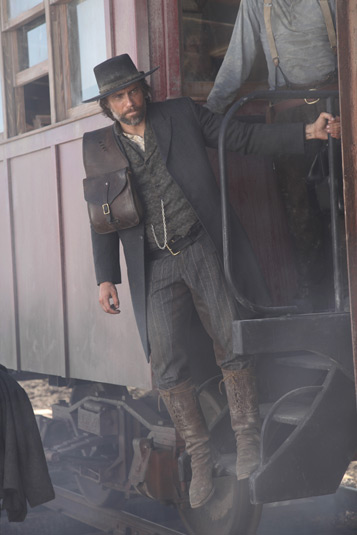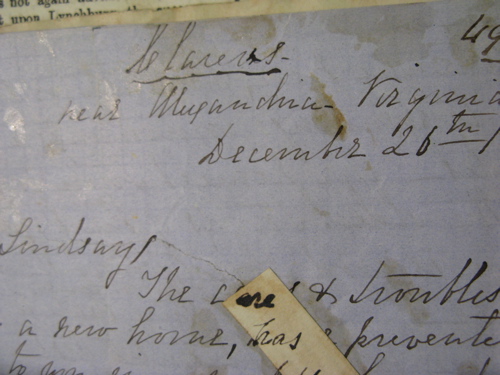AMC’s premier of Hell on Wheels aired last night, and it included beautiful scenes of the Union Pacific railroad building and the Nebraska Territory. The close-up view of the steam locomotive–the behemoth–and its cowcatcher, the explosions blasting the cut through the prairie, the soot and steam pouring forth from the engines, the lines of spike drivers and graders pounding the rails, all gave a visceral sense of what it took to build a railroad. The series offers great promise. And it is admittedly taking on big issues: race, expansion, corruption, and the aftermath of civil war. We should applaud AMC, the cast is terrific, the scenes gorgeous.

But three scenes in particular struck me as ones that raise problems for history and how we remember and understand 1865. These were matters of concern not because such individual behaviors did not exist–there were people like this–but because they run against the broader historical record, so much so as to be questionable. In many ways AMC is creating complex characters against type, a positive move. I hope the complexity is less one-dimensional in the coming episodes, and we can see more nuanced characters. I am only going to sketch what I consider to be the matters of concern. These are not critiques as much as questions.
- When the main character Cullen Bohannon (Anson Mount), the ex-Confederate guerrilla, admits that he was a slaveholder, he also declares that he freed his slaves one year before the Civil War broke out. And further that his “Yankee” spouse led him to this morally right decision. So, we have a man, our hero, who both freed his own slaves and fought for the Confederacy’s claim to protect slavery. The contradiction seems to make Bohannon more sympathetic, but it does so at the expense of larger questions. A braver move might have been to make him a slaveholder period, yet one searching through the aftermath of war and emancipation for away forward, one willing to take risks across the racial divide.
We’ve seen this before with Mel Gibson’s character in The Patriot, although in the Revolutionary age manumission was much more prevalent and therefore plausible, if strained and sappily rendered in that film. In 1860 the idea that Bohannon freed his slaves and employed them on his farm as wage-laborers is more fanciful–with slave prices at their highest in history, with slavery expanding across the South, and with pro-slavery opinion in the white South unopposed. This portrayal is a matter of concern.
- Immediately before Bohannon’s revelation about manumitting his slaves, the former Union soldier, now paymaster for the Union Pacific construction crew, is the first man to utter the n-word. Here too, we are meant to understand that Northerners were equally or more racist than their Confederate counterparts. Their racism is blind, unthinking, and at a distance. He’s the one who acts like the slave driver and beats and whips a freedman from his high horse. Yet, here too the scene runs counter to the volumes of Union soldier letters and diaries which clearly indicate growing appreciation for black soldiers and workers and disdain for the slaveholder class. Men who fought with Sherman came away from the war with mixed emotions. It is true that few wanted freedmen to move north and some reacted violently, usually over labor. It is also true that employers in the railroad industry were particularly segregationist and repressive–most railroads in the North hired absolutely no black men. But, this scene does something more. It puts racism–the electrifying n-work–in the mouth of the North and seems to disregard the widespread white supremacy of the Confederacy.
- When Bohannon, our heroic white ex-Confederate, tells the freedman Elam Ferguson (played by Common) to “let go of the past,” we have to pause and say, really? Just who had trouble letting go of the past? White former Confederates. This scene complicates our understanding–a good thing–but does so in a potentially damaging way. The ex-slave freedman is in his tent, sharpening the knife of vengeance, for all the past wrongs and now for the wrong perpetrated by the white Northern former Union solider paymaster. The feelings of frustration among some freedmen with the post war world of labor was plain–it looked like slavery. Yet we have few instances in the written records of history of former slaves acting with murderous vengeance, much less being talked out of it by former Confederates who tell them to “let go of the past.” Southern whites in December 1865 were, it should be pointed out, fearful of a massive plot by former slaves, one in a long line of nightmarish visions Southern whites had about slavery.
I’ve written in The Iron Way about a more typical scene of racial conflict in 1865. Here’s a selection that might put some of what Hell on Wheels portrayed in perspective:
“The riot at Aquia Creek on the Richmond, Fredericksburg & Potomac Railroad. In Virginia at the end of the war, the volatile mix of black and white workers, former Confederates, and Union soldiers combined in August 1865 to produce one of the first post-war race riots. A simple altercation between a freedman and a white worker who was a former Confederate escalated quickly. Organized mobs of whites and blacks with shovels and clubs threatened one another. The Fifth Maryland, a Unionist but nonetheless Southern regiment, was called in to break up the conflict. Led by an overaggressive lieutenant, the Union soldiers turned first on the black railroad workers and, according to newspaper accounts, began to “break in the doors and windows, and drag the negroes from their beds.” One black man was killed, shot down by the white mob armed with shotguns. Later, after other army units intervened, forty white workers–all of them discharged Confederate soldiers–were arrested, tried, and sentenced to the chain gang for sixty days. According to The Chicago Tribune, a radical Republican paper, “the negroes have been sent back to their work, confident of protection in their rights, and encouragement in their industry.” But the Aquia Creek Riot was a sign of a less secure future. Even The Tribune a few days later repeated an overblown rumor about the Aquia Creek incident: that the freedmen were plotting to “assassinate all the white laborers employed on the railroad” and that they had gathered up “scythes” and “knives” to carry out a massacre. In the fall of 1865 rumors flew around the South among Confederate whites that blacks were preparing for a major uprising in the new year. When Christmas 1865 came and went without an insurrection, nervous whites found other bogeymen.”
I’m eager to see more of AMC’s Hell on Wheels. There are other questions the series raises about the portrayal of the railroad, its builders, and Native peoples. Of particular interest last night is Colm Meaney’s Thomas C. “Doc” Durant. We’ll take these up in a later post.

